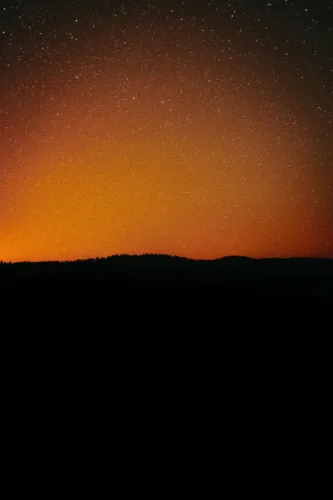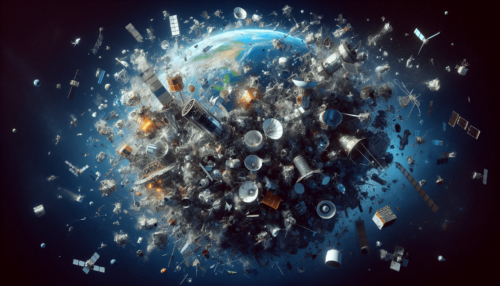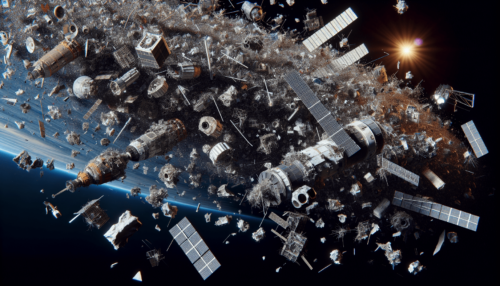In an age defined by rapid advancements in technology and a heightened desire to explore the final frontier, the comprehensive understanding of space safety has become pivotal. This compelling feature by Space Safety Magazine sheds light on the multifaceted issues that span from space debris to the latest trends in space exploration missions. Characterized by a rich blend of astute analyses and timely updates on subjects such as Japan’s moon lander mission, Europe’s blueprint for sovereign broadband constellation and NASA’s adjustment in the Artemis missions, the narrative also segues into consequential topics like the repercussions of space junk on Earth’s atmosphere.
The magazine’s thoughtful exploration extends to the potential of space-based solar power and even the grand discovery of water on exoplanets, emphasizing a holistic approach to space safety and offering readers an intellectually engrossing retreat.
Table of Contents
Understanding Space Junk: A Comprehensive Guide to Cosmic Clutter
Defining Space Junk: What Exactly Is It?
You probably know what junk is, in the garbage-can sense of the word, but have you ever wondered where Earth’s outer space ‘junk drawer’ is? Hope you’re ready for an adventure! Space junk – or more officially known as space debris – refers to defunct man-made objects in space. Mostly, these are remnants from past satellites, rockets, or even tiny paint flecks that peel off these satellites and rockets. Sounds unbelievable, right? But that’s literally what’s out there, above your head!
Historical Context: How Has Space Junk Accumulated Over Time?
Beam back to the 1950s and the dawn of the ‘space age’. Imagine how clean and junk-free outer space was before we started launching stuff there. Each space exploration mission, satellite launch, or even accidents in space, significantly contributed to the accumulation of junk in space, creating a dangerous, swirling storm of debris around our planet. Quite a mess, wouldn’t you agree?
Size and Volume: Just How Much Space Junk Is Out There?
So just how crowded is the orbital neighborhood? Brace yourself, because according to data from space agencies, there are millions of pieces of debris, varying in size from less than 1cm to more significant chunks, like spent rocket stages. It’s like having millions of invisible clutter moving incredibly fast around the Earth at up to 28,000 kilometers per hour. Quite fascinating and chilling at the same time, isn’t it?
The Formation of Space Debris
The Origin of Space Debris: Where Does It All Come From?
We’ve established what space debris is, but where does all this cosmic clutter originate? Simply put, we humans are the source. Any activity humans perform in space not only advances our understanding of the cosmos but also leaves behind remnants. Each time a satellite is launched, dropped stages, and protective shields end up in space. Now can you imagine the amount of debris that we’ve contributed? While space is big, the problem is that the debris stays in the popular orbits, causing eventual ‘traffic jams’!
Space Missions and Their Contribution to Space Debris
Our quest to explore the cosmos has undoubtedly come at a cost. Each space mission, be it successful or failed, has left its unique imprint in the form of space debris. Interestingly (or concerningly), accidental collisions between objects and sometimes deliberate destruction of satellites, have ‘gifted’ our space with an unsightly layer of debris. Oh, the irony that our technological advancements became a source of trash!
The Lifespan of Space Debris: How Long Does It Stay in Space?
Quite like your plastic bag, space debris doesn’t disappear overnight. The lifespan can range from days to centuries, depending on the altitude of the orbit. Lower orbits often have debris re-enter Earth’s atmosphere within several years, while the debris in the higher orbits may continue circling the Earth for centuries. Want a cleaner space? Us too!

This image is property of images.pexels.com.
The Dangers of Space Junk
Potential for Disaster: Real-life Examples of Space Junk Damage
You’d think something as tiny as a paint fleck couldn’t cause much harm, right? But guess again! Space debris, racing at breakneck speeds, packs a powerful punch. Did you know that in 2009, a defunct Russian satellite collided with an operational Iridium communication satellite, creating thousands of pieces of new debris? Or that astronauts aboard the International Space Station have to regularly ‘duck’, moving the station out of the path of space debris? It’s a seemingly calm environment up there, but quite hazardous, don’t you agree?
The Impact on Satellites and Space Missions
Space missions are like a highly complex dance, choreographed to avoid space junk. Increased debris makes it tough not just for new launches but also impacts operational satellites. There were instances when satellite services, such as mobile communications or weather forecasts, were disrupted. Now imagine a cascading series of collisions leading to a junkyard in space that’s almost impossible to traverse. Makes you rethink our space exploration dreams, doesn’t it?
Future Threats: Escalating the Risks with More Launches
As we aim for steeps goals in space exploration and satellite positioning, the debris problem is set to get worse. Case in point: the numerous satellites planned for broadband internet provision. If not properly managed, we’re looking at significantly increasing the amount of space junk, leading to heightened collision risks and potentially transforming the very orbits we rely on into ‘no-go zones’. A bit sobering, isn’t it?
Space Junk’s Influence on the Atmosphere
Space Debris Entering Earth’s Atmosphere
Wish all debris would just fall back to Earth and burn up? Well, many do, but not all. Pieces of space debris occasionally re-enter Earth’s atmosphere. Quite like fallen stars but without the romantic connotations!
What Happens to Space Junk Once It Re-Enters the Atmosphere?
Here’s the good news, most pieces of falling space debris burn up upon re-entry due to heat generated by the atmosphere’s resistance. But larger debris might not wholly disintegrate, potentially causing damage if they land in populated areas. Granted, the odds might be low, but would you bet your house on it?
Effects on Planetary Climate: Fact or Fiction?
Within the scientific community, there’s ongoing debate about whether space debris affects our climate. Some suggest that the dust from burnt-out debris might impact the earth’s temperature, while others disagree. So, myth or reality? Guess we’ll need more tea and more research to solve this riddle!

This image is property of images.pexels.com.
Efforts to Minimize the Impact of Space Debris
Space Agencies’ Role in the Fight Against Space Junk
Space agencies worldwide are playing a huge part in managing the daunting task of space debris mitigation. They share information about the position of space objects, adopt techniques to minimize debris during their missions, and even research how to clean up space. A much-needed effort, don’t you believe?
A Look at Regulations and Standards
The increasing awareness of space debris led to the establishment of various international standards and regulations aimed to reduce space junk. These guidelines encourage measures such as deorbiting satellites at the end of their life. It puts the responsibility on us, the very people who littered space in the first place, to clean it up.
Examples of Successful Debris Clean-Up Missions
Yes, you heard right, clean-up missions! Various technologies are being tested and deployed to clean up space: from dragging nets and harpoons to advanced laser systems. A Japanese experiment recently designed a system to slow down space junk, making it fall towards Earth. Quite a clean-up, don’t you agree?
Exploring Solutions: Clearing the Cosmic Clutter
Current Technologies in Use to Minimize Space Junk
From collision-avoidance maneuvers by changing an active satellite’s path to passivation – draining residual energy from spacecraft and discarded rocket stages – several current technologies aim to minimize space debris. Ingenious, wouldn’t you agree?
Innovations on the Horizon: A Glimpse into Future Solutions
From robotic arms that catch space junk to spacecraft fitted with nets or harpoons, many innovative solutions are on the horizon. Now, doesn’t that give you hope?
Space Clean-Up: Is It a Mission Impossible?
Despite the complexities, clearing the clutter in space isn’t an impossible mission. With collective will, international cooperation, and scientific innovation, we can tackle the challenge. Ready to become a part of the space-junk-busting squad?

This image is property of images.pexels.com.
Impact of Space Junk on Earth-Bound Technologies
Effects on Telecommunication: Satellite TV and Mobile Network Disruptions
Space debris potentially impacts telecommunication systems that rely heavily on satellites. Even minimal interruptions can disrupt daily operations, impact economies, or cause inconveniences. Now wouldn’t that be a bummer when you’re in the middle of your favorite show?
Threats to Global Positioning System (GPS)
Imagine getting lost in an unknown city because the GPS was down due to space debris. Space clutter can pose serious threats to our GPS, impacting everything from navigation to time synchronization across the internet. Time to memorize those road signs?
Space Debris and Concerns for Space-Based Solar Power Projects
Work is underway to harvest solar power in space, converting it to microwaves or lasers and transmitting it to Earth. But could space debris cloud our sunny prospects? It indeed is a concern for these futuristic projects.
Affecting Astronomical Studies: The Space Debris Dilemma
Interference with Telescopic Observations: A Sky Full of Junk
What’s that streak across your star-filled sky frame? Probably a piece of space debris. They often photobomb astronomical observations, making it difficult for astronomers to study the cosmos.
Complications for Asteroid Detection and Other Space Explorations
Space debris doesn’t just photobomb; they can potentially lead to false asteroid detection and add complexity to other space explorations. Imagine the confusion when what you thought was an asteroid turned out to be a chunk of old satellite. Frustrating, isn’t it?

Engaging Communities: How You Can Contribute
Increasing Public Awareness About Space Debris
Did reading this make you more aware of the space debris problem? You’re already part of the solution! Awareness is the first step. Keep learning and share your knowledge for a start!
Steps Individuals Can Take to Make a Difference
Demand sustainable choices from satellite TV providers or even, advocate for responsible space practices. Little steps can make a significant difference. Ready to join the fight?
Inspirational Stories: Communities Making an Impact
From budding scientists inventing space debris tracking systems to grassroots community advocacy for space sustainability, many stories show the difference we can make. Feeling inspired yet?
From Risks to Solutions: The Future of Space Debris Management
Projecting Future Trends: A Hopeful Outlook or Dire Forecast?
While the challenges seem daunting, the growing awareness, science advancements, and international cooperation provide a hopeful outlook. We’ve come a long way, haven’t we?
The Promise of New Technologies
Emerging technologies show promising potential to reduce and manage space debris. We’ve seen giant nets, advanced lasers, and a whole lot more. Isn’t the space trash solution looking brighter?
The Ongoing Quest to Protect Our Cosmos
Our quest to protect the cosmos is as limitless as the cosmos itself. After all, isn’t it our duty to protect the planets and the space that we’ve come to explore and admire? Are you ready for the mission?
With every new finding in the vastness of space, the understanding of space debris evolves. As we continue on our space travels, it’s our responsibility to ensure our journeys don’t impact the celestial world adversely.

Related site – Orbital Fallout: Navigating the Growing Crisis of Space Debris

